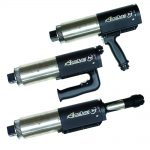Those familiar with wind turbine service documents—either having had to complete them as a technician uptower, or who are the recipients in the shop office—know all too well the delicate nature of these paper forms. Covered in grease, and sometimes torn or illegible, service reports continue to be the preferred method of communicating wind turbine maintenance despite the clear limitations this medium has in field applications. By the time such service information is placed in the hands of decision makers its value has been reduced to markings on a piece of paper, ineligible for cross-reference to other sources of data, rapid fleet-level review, or quick spare parts search to assure the project’s high availability.
Regardless of whether a project site is using the most sophisticated electronic reporting system imaginable, or still using paper service reports, the purpose of visiting each turbine is not to create a record. The record is created to verify and document the turbine’s service. It should be treated as historical evidence of all the work that was performed on the turbine, providing a benefit to the next service technician who will visit the unit and ensuring a well-documented response to maintenance issues. Unfortunately for most wind projects, mounds of historical service information is collected in paper format each year and shuffled away in a file drawer to be resurrected one day in a reactive approach to solving a major issue that has disabled a turbine. Except in rare cases, no intelligence or predictive data on turbine operation is ever developed from paper reports. A huge opportunity in equipment betterment has been lost because technology was not used to create information of value from collected data. Handheld devices such as PDAs, smart phones, and tablet or notebook PCs are no longer on the cutting edge of innovation. They are now commonplace tools of business and daily life. Use of handheld devices in business yields benefits by converting downtime to productive time, and their increased application drives business success by allowing simplification of processes as well as standardization of data. Though there are an infinite number of ways in which a maintenance or inspection process can be automated, software that offers open architecture will allow a service company’s IT department to make changes and customize the program to fit the specific needs of the project. Without high cost, and being wedded to proprietary technology standards, project owners can easily build best practices into mobile applications by continuously improving upon the database structure, input devices, wireless capability, and query features. For example, making changes to an application system-wide can now literally be made to each mobile device over the Internet.
Considering that much of the work completed in the wind turbine O&M industry is performed remotely, instructions such as pop-up messages and training tips can be built into a mobile application. As example, consider the following scenario: A wind technician inspects a faulted wind turbine and identifies damage to the gearbox cooler radiator return hose. The technician correctly inputs this information into the handheld device. Based on the identified damage to the hose, the inspection application might bring up an additional set of questions: location of the damage, type of damage (tear, scrape, puncture, etc.), severity, type of hose (metal sheath, rubber, etc.), and serial markings on the hose. The technician may be asked to photograph the damage for the service report. For each of these questions a button is available to select for more detailed instructions on how to answer each question. This can be a powerful inspection training tool and will help to standardize all answers to ensure the most accurate service inspection possible.
To ensure the quality and consistency of a maintenance service, automating the exact way a process should be completed in every instance is an important value contribution. Mobile service applications can validate that the appropriate processes are done in the appropriate order. This is accomplished through a variety of means such as requiring specific information to be captured before moving to the next data field, requiring a digital photo of the as-found condition of a component, automatically capturing time and date stamps for work, and automatically checking inventory levels before replacing a part. These important data fields can be used proactively to assess the condition of a turbine prior to its next scheduled service or to serve as a maintenance timeline for responding to subsequent faults.
In today’s age of technology, paper is an increasingly subordinate communication medium. In many respects, it survives only because we allow it to live. The rise in mobile and wireless technology capability is the catalyst that the wind industry needs in order to keep pace with owners’ eager demands for real-time turbine status, particularly when MW-class turbines are at risk. Managing service data on an electronic platform will allow wind farm operators to maximize the use of historical information to optimize reliability and equipment longevity, minimize downtime, and improve the analysis of more comprehensive information. Until we are able to embrace digital technology in the service of turbines, we will continue to lose out on the full value of the data captured at the turbine by the service technician.
































